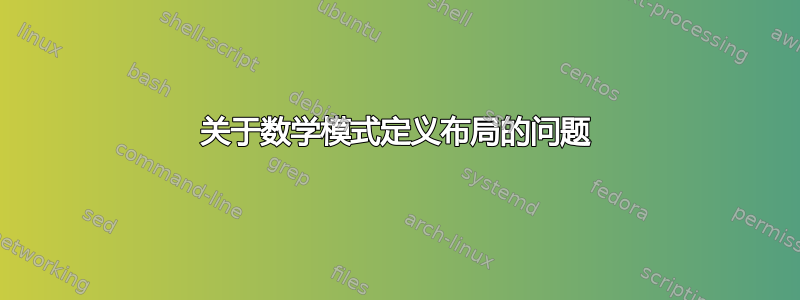
我一直在努力
S0 = 0
Si+1 = { .... }
U { ........}
U { ... }
在 LaTeX 中定义布局,但几个小时都没有成功。
我的主要问题是,工会必须以不同于的方式进行调整=。
我希望有人可以帮助我。
答案1
这是另一种情况(作为一般规则的例外),将关系符号前可以&帮助:
\begin{align}
S_{0}={} & 0\\
\begin{split}
S_{i+1}={}& \mathbin{\hphantom{\cup}}\{...\}\\
& \cup\{...\}\\
& \cup\{...\}
\end{split}
\end{align}
如果不需要对公式进行编号,可以省略和\begin{split},\end{split}并将align改为align*。
这样做的原因是为了确保\cup符号后的间距正确。

答案2
我使用的amsmath环境split和幻影来表示失踪乌在第二个等式中:
\documentclass[varwidth,fleqn]{standalone}
\usepackage{amsmath}
\begin{document}
\noindent
\begin{equation}
\begin{split}
S_0 = & 0 \\
S_{i+1} = & \phantom{U} \left\{ \ldots \right\}\\
& U \left\{ \ldots \right\}
\end{split}
\end{equation}
\end{document}

如果愿意的话,可以省略下标。
我刚刚注意到这可能是数学模式中的多重水平对齐
已更新 - 在采纳评论中的建议后,这是我的第二看法:
\documentclass[varwidth,fleqn]{standalone}
\usepackage{amsmath}
\begin{document}
\noindent
\begin{equation}
\begin{split}
S_{0\phantom{+1}} & = 0 \\
S_{i+1} & = \phantom{\cup} \left\{ \ldots \right\}\\
& \mathrel{\phantom{=}} \cup \left\{ \ldots \right\}
\end{split}
\end{equation}
\end{document}

答案3
您当前的 ASCII 对齐建议两个“列”都l向左对齐。因此,这里有一个array实现输出的方法:

\documentclass{article}
%\usepackage{amsmath}% http://ctan.org/pkg/amsmath
\begin{document}
\[
\begin{array}{l@{\;}c@{\;}l}
S_0 &=& 0 \\
S_{i+1} &=& \phantom{\cup}\:\{\ldots\} \\
& & \cup\:\{\ldots\} \\
& & \cup\:\{\ldots\}
\end{array}
\]
\end{document}
不要使用U进行集合并集,而要使用\cup。间距调整(使用\;和可纠正由于列间距而\:引入的任何问题。array
align您会注意到,垂直对齐与使用来自的其他解决方案的垂直对齐略有不同(更紧密)。amsmath。要获得类似的对齐,请使用\\[\jot]而不是仅仅 来作为行尾\\。


